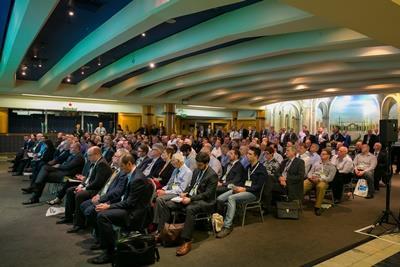
The inaugural Freight in the City Expo held on 27 October 2015 at London’s Alexandra Palace brought together experts in the field of urban logistics as well as the latest technology to enable sustainable city deliveries.
The expo comprised a series of seminars focusing on clean, safe and quiet and efficient themes, showcasing vehicles, technology and operational systems for urban areas.
“We must remember that freight and logistics is the lifeblood of this country,” said TfL MD of surface transport Leon Daniels in his keynote speech. “We are delighted to be here demonstrating that we are part of the support that the freight industry needs to keep London a buzzing, economically thriving city.”
Daniels said that the capital has not been as busy as it is today since its 1930s peak, with a further two million people predicted to move to London by 2031, generating an additional five million road journeys on top of the 24 million already taking place.
“Air quality, pollution and safety is not just about London. We are determined to drive forward, working with other agencies and safer truck logistics programmes across the country,” he added. “Freight in the City demonstrates all that is good in this industry.”
Truck safety
HGV safety is an essential priority in urban environments and expert speakers talked in-depth about the significant advancements in vehicle technology and industry efforts to make city deliveries safer for all road users.
Steve Summerskill, senior lecturer in product and industrial design at Loughborough University, presented research into HGV blind spots, commissioned by TfL. It studied 19 models, including some of the latest low-entry vehicles to provide a comparison with standard configuration designs.
While results showed much variability between blind spots on standard cab designs, low-entry vehicles were shown to have superior direct vision, both at the sides and the front of the cab. It was also identified that variables, such as better window design and driver positioning in standard cab configurations could also help reduce blind spots.
The university is looking to define a standard for direct vision from truck cabs, which it would like to see adopted across the EU. It will also look at driver cognitive overload. “Is it reasonable to expect a driver to use six mirrors and three or more windows to look for vulnerable road users?” asked Summerskill.

Nick Blake, head of engineering at Mercedes-Benz Trucks, spoke of rapid advancements in vehicle technology, such as blind spot detection systems, automatic braking and autonomous vehicles, saying that “technology is moving ahead of legislation”.
Blake urged the industry to rethink the type of delivery vehicle used in cities for all types of distribution, and not only focus on construction lorries. “Should we be using the same vehicle trunking up and down the motorway very successfully for delivering goods in an urban environment? I would suggest not.”
Sean McGrae, senior manager national transport, Tarmac, said the company’s focus on safety had paid dividends with reduced blameworthy incident rates, lower insurance premiums, increased customer confidence and contracts won based on its safety credentials.
Tarmac took the decision to not only fit Clocs standard equipment on its own-account fleet, but also fund the cost of safety gear across its subcontractors’ vehicles. “We funded the underruns and side sensors and audible alerts, and we’re now funding their Fors membership and compliance.”
The company also fits alcohol-testing interlock devices on its own vehicles as well as a telephone system that will not allow calls to be answered while the ignition is on. McGrae stressed that vulnerable road user safety training for drivers was the key to ensuring all the initiatives were effective.
Compliance
With several compliance schemes now established to lessen the environmental effect and boost the safety of HGV movements in urban areas, is there a need for one, overall nationally-recognised standard?

DHL vice president for innovation Phil Roe (pictured left) suggested one national standard is not the answer, however he believed a more unified approach to compliance would make it clearer for local authorities and operators to adopt best practice operations.
“Regional devolution means that national standards don’t work very well any more,” Roe explained, because local needs are seen to supersede those national minimum standards.
He acknowledged the benefits that all the industry schemes have achieved, but called for more collaboration between them so as not to hinder the adoption of new technology in the future.
“What we would like to see is not a new scheme – and I absolutely want to stress that – but what we do need is a more unified approach for our compliance schemes.”

Hannah White, freight and fleet project manager at TfL, (pictured left) spoke of the advances in the Clocs initiative, with more than 20,000 vehicles now retrofitted with vulnerable road user safety kit and 19,000 drivers trained in safer urban driving.
Clocs wanted to inform people purchasing new trucks to ensure they are using the right models for urban work, following the research carried out by Loughborough University.
An off-road cab configuration is, on average, about a third higher than an on-road standard distribution cab, she said. “We need to understand how we can encourage these vehicles to be lower.”
Clocs has commissioned research into use of construction vehicles and discovered that off-road specs are the vehicle of choice, despite 49% never going off road.
“We also want to improve operator confidence to spec safer urban trucks by appropriately grading sites to enable their use of lower cabs with better vision,” she said. Clocs is developing a safer tips guide, which will be launched next year.














